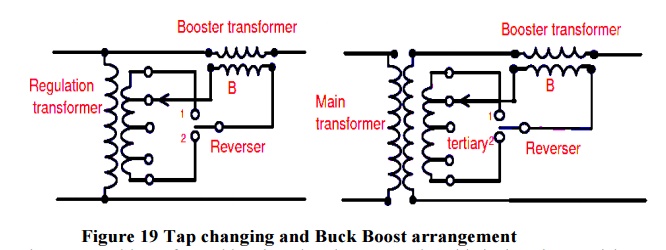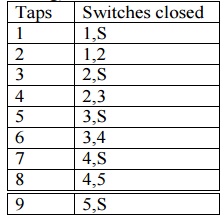Chapter: Electrical machines : Transformer
Tap Changing in Transformer
Tap
Changing
Regulating
the voltage of a transformer is a requirement that often arises in a power
application or power system. In an application it may be needed
1.
To supply a desired voltage to the load.
2.
To counter the voltage drops due to loads.
3.
To counter the input supply voltage changes on
load.
On a
power system the transformers are additionally required to perform the task of
regulation of active and reactive power flows.

The
voltage control is performed by changing the turns ratio. This is done by provision
of taps in the winding. The volts per turn available in large transformers is
quite high and hence a change of even one turn on the LV side represents a
large percentage change in the voltage. Also the LV currents are normally too
large to take out the tapping from the windings. LV winding being the inner
winding in a core type transformer adds to the difficulty of taking out of the
taps. Hence irrespective of the end use for which tapping is put to, taps are
provided on the HV winding. Provision of taps to control voltage is called tap
changing. In the case of power systems, voltage levels are sometimes changed by
injecting a suitable voltage in series with the line.
This may
be called buck-boost arrangement. In addition to the magnitude, phase of the
injected voltage may be varied in power systems. The tap changing arrangement
and buck boost arrangement with phase shift are shown in Fig. 42. Tap changing
can be effected when a) the transformers is on no- load and b) the load is
still remains connected to the transformer. These are called off load tap
changing and on load tap changing. The Off load taps changing relatively costs
less. The tap positions are changed when the transformer is taken out of the
circuit and reconnected. The on-load tap changer on the other hand tries to
change the taps without the interruption of the load current.
In view
of this requirement it normally costs more. A few schemes of on-load tap
changing are now discussed. Reactor method The diagram of connections is shown
in Fig. 43. This method employs an auxiliary reactor to assist tap changing.
The switches for the taps and that across the reactor(S) are connected as
shown. The reactor has a center tapped winding on a magnetic core. The two ends
of the reactor are connected to the two bus bars to which tapping switches of
odd/even numbered taps are connected. When only one tap is connected to the
reactor the shorting switch S is closed minimizing the drop in the reactor. The
reactor can also be worked with both ends connected to two successive taps. In
that case the switch ’S’ must be kept open. The reactor limits the circulating
current between the taps in such a situation. Thus a four step tapped winding
can be used for getting seven step voltage on the secondary(see the table of
switching).

Reactor
method the diagram of connections is shown in Fig. 43. This method employs an
auxiliary reactor to assist tap changing. The switches for the taps and that
across the reactor(S) are connected as shown. The reactor has a center tapped
winding on a magnetic core. The two ends of the reactor are connected to the
two bus bars to which tapping switches of odd/even numbered taps are connected.
When only one tap is connected to the reactor the shorting switch S is closed
minimizing the drop in the reactor. The reactor can also be worked with both
ends connected to two successive taps. In that case the switch ’S’ must be kept
open. The reactor limits the circulating current between the taps in such a
situation. Thus a four step tapped winding can be used for getting seven step
voltage on the secondary (see the table of switching). The advantage of this
type of tap changer is
1.
Load need not be switched.
2.
More steps than taps are obtained.
3.
Switches need not interrupt load current as a
alternate path is always provided.
The major
objection to this scheme seems to be that the reactor is in the circuit always
generating extra loss. Parallel winding, transformer method In order to
maintain the continuity of supply the primary winding is split into two
parallel circuits each circuit having the taps. as
Two
circuit breakers A and B are used in the two circuits. Initially tap 1a and 1b
are closed and the transformer is energized with full primary voltage. To
change the tap the circuit breaker A is opened momentarily and tap is moved
from 1a to 2a. Then circuit breaker A is closed. When the circuit A is opened
whole of the primary current of the transformer flows through the circuit B. A
small difference in the number of turns between the two circuit exists. This
produces a circulating current between them. Next, circuit breaker B is opened
momentarily, the tap is changed from 1b to 2b and the breaker is closed. In
this position the two circuits are similar and there is no circulating current.
The circulating current is controlled by careful selection of the leakage
reactance.
Generally,
parallel circuits are needed in primary and secondary to carry the large
current in a big transformer. Provision of taps switches and circuit breakers
are to be additionally provided to achieve tap changing in these machines.
Series booster method in this case a separate transformer is used to buck/boost
the voltage of the main transformer. The main transformer need not be having a
tapped arrangement. This arrangement can be added to an existing system also.
It shows the booster arrangement for a single phase supply. The reverser switch
reverses the polarity of the injected voltage and hence a boost is converted
into a buck and vice versa. The power rating of this transformer need be a
small fraction of the main transformer as it is required to handle only the
power associated with the injected voltage.
The
advantage of this type of tap changer are The major objection to this scheme
seems to be that the reactor is in the circuit always generating extra loss.
Parallel winding, transformer method In order to maintain the continuity of
supply the primary winding is split into two parallel circuits each circuit
having the taps. Two circuit breakers A and B are used in the two circuits.
Initially tap 1a and 1b are closed and the transformer is energized with full
primary voltage. To change the tap the circuit breaker A is opened momentarily
and tap is moved from 1a to 2a. Then circuit breaker A is closed. When the
circuit A is opened whole of the primary current of the transformer flows
through the circuit B. A small difference in the number of turns between the
two circuits exists. This produces a circulating current between them. Next,
circuit breaker B is opened momentarily, the tap is changed from1b to 2b and
the breaker is closed. In this position the two circuits are similar and there
is no circulating current. The circulating current is controlled by careful
selection of the leakage reactance. Generally, parallel circuits are needed in
primary and secondary to carry the large current in a big transformer.
Provision of taps switches and circuit breakers are to be additionally provided
to achieve tap changing in these machines. Series booster method in this case a
separate transformer is used to buck/boost the voltage of the main transformer.
The main transformer need not be having a tapped arrangement.
This
arrangement can be added to an existing system also. It shows the booster
arrangement for a single phase supply. The reverser switch reverses the
polarity of the injected voltage and hence a boost is converted into a buck and
vice versa. The power rating of this transformer need be a small fraction of
the main transformer as it is required to handle only the power associated with
the injected voltage. One precaution to be taken with this arrangement is that
the winding must output side. In smaller ratings this is highly cost effective.
Two winding arrangements are also possible. The two winding arrangement provides
electrical isolation. Not be open circuited. If it gets open circuited the core
(B in fig) gets highly saturated.
In spite
of the small ratings and low voltages and flexibility, this method of voltage
control costs more mainly due to the additional floor space it needs. The
methods of voltage regulation discussed so far basically use the principle of
tap changing and hence the voltage change takes place in steps. Applications
like a.c. and D.C. motor speed control, illumination control by dimmers,
electro-chemistry and voltage stabilizers need continuous control of voltage.
This can be obtained with the help of moving coil voltage regulators. Moving
coil voltage regulator shows the physical arrangement of one such transformer.
a, b are the two primary windings wound on a long core, wound in the opposite
sense. Thus the flux produced by each winding takes a path through the air to
link the winding. These fluxes link their secondaries a2 and b2. A short
circuited moving coil s is wound on the same limb and is capable of being held
at any desired position. This moving coil alters the inductances of the two
primaries. The sharing of the total applied voltage thus becomes different and also the induced emf in
the secondaries a2 and b2.
The total
secondary voltage in the present case varies from 10 percent to 20 percent of
the input in a continuous manner. The turn’s ratios of a1: a2 and b1: b2 are
4.86 and 10.6 respectively. 5 4.86 + 95 10.6 = 10% when s is in the top
position. In the bottom position it becomes 95 4.86 + 5 10.6 = 20%. By
selecting proper ratios for the secondaries a2 and b2 one can get the desired
voltage variation. Sliding contact regulators these have two winding or auto
transformer like construction. The winding from which the output is taken is
bared and a sliding contact taps the voltage. The minimum step size of voltage
change obtainable is the voltage across a single turn. The conductor is chosen
on the basis of the maximum load current on the output side. In smaller ratings
this is highly cost effective. Two winding arrangements are also possible. The
two winding arrangement provides electrical isolation also.
Related Topics